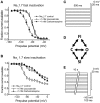Recent developments regarding voltage-gated sodium channel blockers for the treatment of inherited and acquired neuropathic pain syndromes
- PMID: 22007172
- PMCID: PMC3185237
- DOI: 10.3389/fphar.2011.00054
Recent developments regarding voltage-gated sodium channel blockers for the treatment of inherited and acquired neuropathic pain syndromes
Abstract
Chronic and neuropathic pain constitute significant health problems affecting millions of individuals each year. Pain sensations typically originate in sensory neurons of the peripheral nervous system which relay information to the central nervous system (CNS). Pathological pain sensations can arise as result of changes in excitability of these peripheral sensory neurons. Voltage-gated sodium channels are key determinants regulating action potential generation and propagation; thus, changes in sodium channel function can have profound effects on neuronal excitability and pain signaling. At present, most of the clinically available sodium channel blockers used to treat pain are non-selective across sodium channel isoforms and can contribute to cardio-toxicity, motor impairments, and CNS side effects. Numerous strides have been made over the last decade in an effort to develop more selective and efficacious sodium channel blockers to treat pain. The purpose of this review is to highlight some of the more recent developments put forth by research universities and pharmaceutical companies alike in the pursuit of developing more targeted sodium channel therapies for the treatment of a variety of neuropathic pain conditions.
Keywords: Nav1.7; Nav1.8; TRPV1; neuropathic pain; resurgent currents; voltage-gated sodium channel.
Figures




Similar articles
-
Increased Resurgent Sodium Currents in Nav1.8 Contribute to Nociceptive Sensory Neuron Hyperexcitability Associated with Peripheral Neuropathies.J Neurosci. 2019 Feb 20;39(8):1539-1550. doi: 10.1523/JNEUROSCI.0468-18.2018. Epub 2019 Jan 7. J Neurosci. 2019. PMID: 30617209 Free PMC article.
-
Unusual Voltage-Gated Sodium Currents as Targets for Pain.Curr Top Membr. 2016;78:599-638. doi: 10.1016/bs.ctm.2015.12.005. Epub 2016 Feb 2. Curr Top Membr. 2016. PMID: 27586296 Review.
-
Human voltage-gated sodium channel mutations that cause inherited neuronal and muscle channelopathies increase resurgent sodium currents.J Clin Invest. 2010 Jan;120(1):369-78. doi: 10.1172/JCI40801. Epub 2009 Dec 28. J Clin Invest. 2010. PMID: 20038812 Free PMC article.
-
Navβ4 regulates fast resurgent sodium currents and excitability in sensory neurons.Mol Pain. 2015 Sep 25;11:60. doi: 10.1186/s12990-015-0063-9. Mol Pain. 2015. PMID: 26408173 Free PMC article.
-
Voltage gated sodium channels as therapeutic targets for chronic pain.J Pain Res. 2019 Sep 9;12:2709-2722. doi: 10.2147/JPR.S207610. eCollection 2019. J Pain Res. 2019. PMID: 31564962 Free PMC article. Review.
Cited by
-
Current Status of the New Antiepileptic Drugs in Chronic Pain.Front Pharmacol. 2016 Aug 25;7:276. doi: 10.3389/fphar.2016.00276. eCollection 2016. Front Pharmacol. 2016. PMID: 27610084 Free PMC article. Review.
-
Bioactive marine drugs and marine biomaterials for brain diseases.Mar Drugs. 2014 May 2;12(5):2539-89. doi: 10.3390/md12052539. Mar Drugs. 2014. PMID: 24798925 Free PMC article.
-
Inhibition of Inactive States of Tetrodotoxin-Sensitive Sodium Channels Reduces Spontaneous Firing of C-Fiber Nociceptors and Produces Analgesia in Formalin and Complete Freund's Adjuvant Models of Pain.PLoS One. 2015 Sep 17;10(9):e0138140. doi: 10.1371/journal.pone.0138140. eCollection 2015. PLoS One. 2015. PMID: 26379236 Free PMC article.
-
State-dependent block of voltage-gated sodium channels by the casein-kinase 1 inhibitor IC261.Invest New Drugs. 2017 Jun;35(3):277-289. doi: 10.1007/s10637-017-0429-0. Epub 2017 Feb 6. Invest New Drugs. 2017. PMID: 28164251
-
Inhibition of Fast Nerve Conduction Produced by Analgesics and Analgesic Adjuvants-Possible Involvement in Pain Alleviation.Pharmaceuticals (Basel). 2020 Apr 5;13(4):62. doi: 10.3390/ph13040062. Pharmaceuticals (Basel). 2020. PMID: 32260535 Free PMC article. Review.
References
-
- Akopian A. N., Souslova V., England S., Okuse K., Ogata N., Ure J., Smith A., Kerr B. J., Mcmahon S. B., Boyce S., Hill R., Stanfa L. C., Dickenson A. H., Wood J. N. (1999). The tetrodotoxin-resistant sodium channel SNS has a specialized function in pain pathways. Nat. Neurosci. 2, 541–54810.1038/9195 - DOI - PubMed
-
- Amaya F., Wang H., Costigan M., llchorne A. J., Hatcher J. P., Egerton J., Stean T., Morisset V., Grose D., Gunthorpe M. J., Chessell I. P., Tate S., Green P. J., Woolf C. J. (2006). The voltage-gated sodium channel Na(v)1.9 is an effector of peripheral inflammatory pain hypersensitivity. J. Neurosci. 26, 12852–1286010.1523/JNEUROSCI.4015-06.2006 - DOI - PMC - PubMed
Grants and funding
LinkOut - more resources
Full Text Sources
Other Literature Sources

